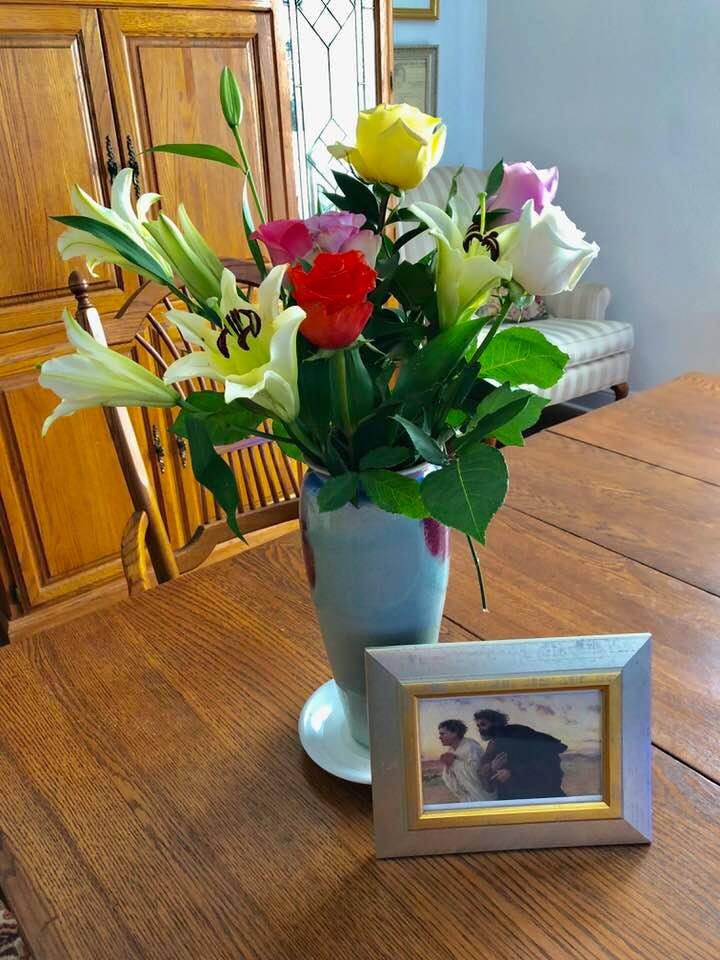Peter and John Race to Christ’s Tomb
They didn't believe Mary Magdalene. Thomas wasn't the only doubter.

A postcard that my son purchased for me with this image on it is my favorite souvenir from my only trip to France in 1995 or so. Actually, it’s my only souvenir from that trip, aside from some photos stuck away in a dresser drawer. I’m not into buying souvenirs.
After I signed up for a yoga retreat in France using a brochure I found at California Yoga in Palo Alto (I hadn’t yet realized what I now believe are the spiritual dangers of yoga, and I had been practicing yoga for years to help my back), I offered to pay my grown son Liberty’s way as a sort of a bribe to gain his company during the trip. He had been attending yoga classes with me to try to get help from his own chronic back paing. I joked that he could serve as my beast of burden, since we didn’t have wheeled luggage, as it wasn’t common yet.
His help was especially invaluable when he lifted my as-usual-excessive-amount-of-luggage to and from a rack above our heads in a TGV (Train à Grande Vitesse, "high-speed train") railway carriage, when we traveled from Paris to Montpellier in the south of France for the first part of our itinerary.
After we had spent a week at the yoga retreat surrounded by vineyards in Languedoc Roussillon about fifty miles north of Montpellier, we drove north in our rental car back to Paris again. After three days of touring in and around the city of lights, I needed a rest, so Liberty went to Musée d’Orsay the next day without me.
I was sad to miss the museum, but I was happy when Liberty brought me back a postcard with the image of Saints John and Peter racing to the tomb of Christ on Easter morning. He is not a believer (yet, I hope), but he knew I’d love it. The painting portrays the emotions that the two apostles must have been feeling, and it hints at the glory of the Resurrection with the pale, golden, dawn of that greatest of all Sundays lighting up the sky and the fields through which they were running.
They had just spent three dark days in pain and grief. They had helplessly watched their beloved Master be taken away from them, beaten, judged, publicly tortured, mocked, and crucified. He died, and His lifeless body had been put into a tomb. Such a horror! He had told them He would rise again, but, as was true about many other things He told them, they couldn’t really grasp yet what that might mean.
Nothing like that had happened since the world began, that a man would rise from the dead. Jesus had resurrected others, but it was hardly comprehensible that He could resurrect Himself. Even though they had seen His Transfiguration not long before, the reality of His passion and death had intervened and obscured the promise of that vision.
These were practical men, who not long ago had been fishermen. Everybody knows that when you are dead, you are gone from this earth for good. Hope seemed dead.
But then that morning, hope had risen again. They had just heard from Mary Magdalene that she had seen the Lord. She had gone early to the tomb with some other women planning to anoint His dead body. Instead, to her great joy, she had met Him alive in His risen body. Jesus had told her to go back and tell Peter and the other disciples to meet Him in Galilee.
St. Matthew’s Gospel said they didn’t believe her. Peter and John raced to the tomb because they wanted to see if it was empty for themselves.
Matthew 16:9-14: “But he rising early the first day of the week, appeared first to Mary Magdalen, out of whom he had cast seven devils. She went and told them that had been with him, who were mourning and weeping. And they hearing that he was alive, and had been seen by her, did not believe. And after that he appeared in another shape to two of them walking, as they were going into the country. they going told it to the rest: neither did they believe them. At length he appeared to the eleven as they were at table: and he upbraided them with their incredulity and hardness of heart, because they did not believe them who had seen him after he was risen again.”
The Gospels of Easter are surprisingly full of accounts of the apostles and the disciples not believing one another when told that the Lord had risen. And let’s not forget about doubting Thomas, who was gone when Jesus appeared in the upper room and refused to believe his fellow Apostles when they told him what they had seen.
Jesus had told them all many times He would rise again. Their forgetfulness is amazing. Sort of like ours.
I framed the postcard with the affecting image that shows Saints Peter and John racing to the tomb with their hopes and fears written on their faces, and every year I bring it out again on Easter Sunday and put it on the dining room table, where it stays until the end of the Easter season at Pentecost. Every time I look at it, I rejoice again.
Resurrexit sicut dixit! Alleluia!
Resurrexit, vere!
He has risen as He said! Alleluia! Truly, He has risen!
For more about the painter, Eugène Burnand, and this work of art, you can read this Crisis magazine article hyperbolically titled, “The Greatest Easter Painting Ever Made.”
This post was originally published at Dappled Things Deep Down Things blog. It has been revised.





